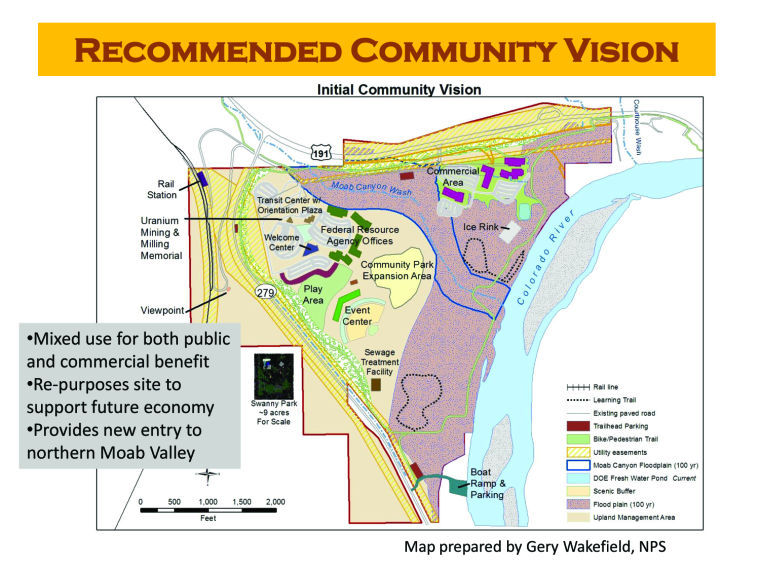The Grand County Council approved a resolution to endorse the Community Vision for the future use of the Uranium Moab Tailings Remedial Action (UMTRA) site north of Moab.
The Community Vision recommendation will be given to the Department of Energy (DOE) to consider for the future use of the UMTRA site.
The plan was first presented to the county council at their Dec. 17, 2013 meeting by the Site Futures Committee chair Russ Von Koch and vice-chair Saxon Shape.
Councilman Lynn Jackson expressed concern at the meeting, that while the plan addressed the county needs, the land, when re-mediated, should be deeded to the county.
Von Koch returned to the county council Tuesday, Jan. 21 with a revised resolution that addressed the council’s concern regarding the recommendation for future ownership of the site.
The Community Vision plan was adapted from four plans that were drafted by the Site Futures Committee after receiving public input since May.
The Moab Tailings Project Steering Committee accepted the Community Vision plan presented by the Site Futures Committee at their meeting Wednesday, Nov. 13. The project steering committee endorsed the Community Vision before it was presented to the county council in December.
The DOE now owns the 474-acre UMTRA site north of Moab that was used as an uranium mill and tailings pond between 1956 and 1984.
In 2009 the DOE began the removal of 16 million tons of tailings from the site to a permanent disposal site 30 miles north of Moab near Crescent Junction. One third of the tailings have already been moved. It is projected that the removal of the tailings will not be completed until 2025 or 2029, depending on the level of federal funding for the remediation.
The Site Futures Committee began seeking public input in May 2013 for how the site should be used after the clean-up is completed. Over several months, the committee took those suggestions to draft a vision to be presented to the Moab Tailings Project Steering Committee.
One resounding theme presented in all the proposed site plans was that it should be a community asset and provide an appealing gateway to Moab.
The county council was most concerned about the recommendation to transfer the site for use by federal agencies within the Community Vision. The council specified that the recommendation should be that the transfer of the land ownership should be to the county no later than the completion of the project.
“This isn’t a binding agreement. There is nothing in this that binds us to an agreement. We’re basically just asking them to consider transferring the ownership of the property to Grand County,” said councilman Gene Ciarus.
Another change in the resolution was to remove clauses that required agreement to changes to the Community Vision by the City of Moab.
“This will disentangle future versions,” Jackson said. “The county can act independently.”
Jackson said that there may have been some misunderstanding within the community regarding the council’s stance regarding the Community Vision.
“We’re not opposed to the vision, we just want it to be clear that the land will be turned over to Grand County ownership,” Jackson said. “We’re pretty comfortable with the plan. It was just minor changes.”
The Community Vision plan includes elements of the four plans presented to the public at the Site Futures meeting in September.
These elements include a rail station, a transit center and bike and pedestrian trails. It may also include a community park play area, a commercial area, federal offices, an ice rink and an event center. Because city sewer services are not available on the north side of the Colorado River, it is also advised for the property to have its own wastewater treatment site.
There are limitations to developing the property.
Although the entire site is 474 acres, due to 171 acres of floodplain from the Moab Canyon Wash and Colorado River, 104 acres of soil contamination, 102 acres of easements, and 29 acres of steep slopes – there may be less than 100 acres of viable land.
Lee Shenton, the site liaison between Grand County and the DOE, said the endorsement is a starting point for future planning.
Between 2014 and 2025 the vision should be updated, he said, by using additional public and agency input and to continue to foster community discussion on potential site management.
Before 2025, when the remediation at the site should be completed as per current funding for the clean-up, a site transition plan could be drafted.
Site Futures recommendation to be given to DOE
“We’re not opposed to the vision, we just want it to be clear that the land will be turned over to Grand County ownership.”




